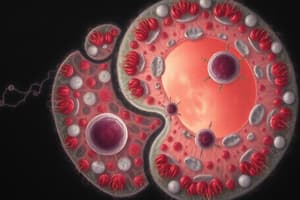Podcast
Questions and Answers
What is the cell cycle?
What is the cell cycle?
- A type of asexual reproduction
- The final stage of cell division
- A phase of mitosis
- The process of cell division and DNA duplication (correct)
What phase of the cell cycle does a typical cell spend most of its life?
What phase of the cell cycle does a typical cell spend most of its life?
Interphase
What is asexual reproduction?
What is asexual reproduction?
A method by which offspring arise from a single organism, inheriting genes from that parent only.
What happens during prophase?
What happens during prophase?
What occurs during metaphase?
What occurs during metaphase?
What happens during anaphase?
What happens during anaphase?
What occurs during telophase?
What occurs during telophase?
What is mitosis?
What is mitosis?
What is cytokinesis?
What is cytokinesis?
What is binary fission?
What is binary fission?
What is budding?
What is budding?
What is regeneration?
What is regeneration?
What is genetic material?
What is genetic material?
Flashcards are hidden until you start studying
Study Notes
Cell Cycle and Mitosis
- Cell cycle encompasses the stages a cell goes through leading to division and DNA replication.
- Interphase is the longest phase in the cell cycle where cells spend the majority of their lifespan.
Asexual Reproduction
- Asexual reproduction results in offspring from a single parent organism, with offspring inheriting genes solely from that parent.
Stages of Mitosis
- Prophase: Chromatin condenses into visible chromosomes, marking the beginning of mitosis.
- Metaphase: Chromosomes align at the cell's equator and attach to spindle fibers, facilitating the separation process.
- Anaphase: Chromatids move apart toward opposite poles of the spindle apparatus, ensuring each daughter cell receives a complete set of chromosomes.
- Telophase: Chromosomes reach the opposite poles; nuclear membranes reform around each set, resulting in two distinct nuclei.
Mitosis and Cytokinesis
- Mitosis is the process of nuclear division followed by cytokinesis, leading to the formation of two genetically identical daughter cells.
- Cytokinesis specifically refers to the division of the cytoplasm, following mitosis, resulting in two separate daughter cells.
Asexual Reproductive Methods
- Binary Fission: Common in prokaryotes; a simple form of asexual reproduction where a cell divides into two equal halves.
- Budding: A process where a new organism develops from a bud on the parent, occurring through localized cell division.
- Regeneration: Involves the regrowth of lost or damaged body parts, often observed in certain organisms.
Genetic Material
- Genetic material is primarily composed of DNA, which carries the hereditary information essential for the functioning and reproduction of living organisms.
Studying That Suits You
Use AI to generate personalized quizzes and flashcards to suit your learning preferences.




